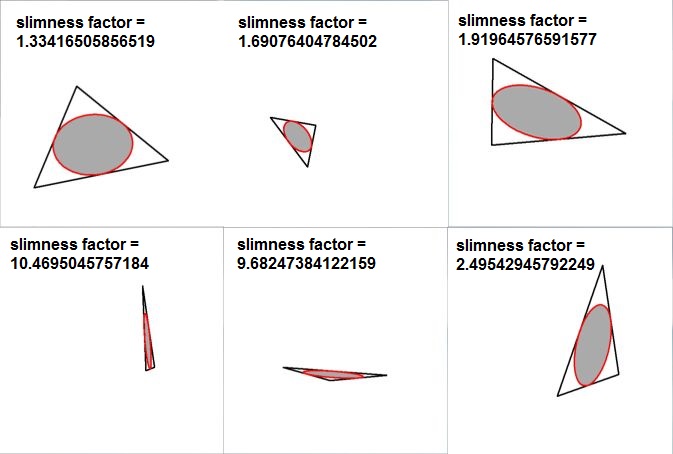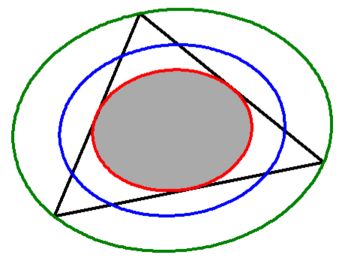

Update. It may be questioned if choosing one of the triangle views, as 3 vertices (1),
as 3 rods (2), as a flat plate (3), has any influence on the slimness factor.
It can be easily proved that the center of gravity / midpoint of the triangle in all three
cases is the same : $\mu_x = (x_1+x_2+x_3)/3 \; ; \; \mu_y = (y_1+y_2+y_3)/3$ .
Now define the following quantities, where it is noted that the last two can be derived
from the first one:
$$
s_{xy} = (x_1-x_2)(y_1-y_2)+(x_2-x_3)(y_2-y_3)+(x_3-x_1)(y_3-y_1) \\
s_{xx} = (x_1-x_2)^2+(x_2-x_3)^2+(x_3-x_1)^2 \quad ; \quad
s_{yy} = (y_1-y_2)^2+(y_2-y_3)^2+(y_3-y_1)^2
$$
Then the second order moments of inertia / variances in the vertex case can be rewritten as:
$\sigma_{xx} = s_{xx}/9$ , $\sigma_{yy} = s_{yy}/9$ , $\sigma_{xy} = x_{xy}/9$ .
Compare this with the quantities of the flat plate case in the abovementioned
paper .
Then it turns out that the formulas are very similar :
$\sigma_{xx} = s_{xx}/36$ , $\sigma_{yy} = s_{yy}/36$ , $\sigma_{xy} = s_{xy}/36$ .
Which means that the ellipse in the vertex case is larger than the ellipse
in the flat plate case, twice as large to be precise, because $\sqrt{36/9}=2$ .
In the flate plate case, we get the Steiner Inellipse and
in the vertex case, we get the Steiner Outellipse .
For the slimness factor, this makes no difference.
EDIT. Three Rods case. If I am right with my calculated ratio $3:6:12$ (instead of Matt's $3:8:12$)
then we have the following picture for the $\color{green}{vertex}$ case, the $\color{blue}{rods}$ case
and the flat $\color{red}{plate}$ case.
Conclusion: The slimness factor in all three cases is the same.

Coordinate independence. The formula for the Trace can be rewritten as follows: $$ \mbox{Tr} \sim (s_{xx}+s_{yy})/2 = (a^2+b^2+c^2)/2 $$ Where $a,b,c$ are the lengths of the triangle edges, as usual. The Determinant is conjectured to be proportional to the square of the area of the triangle. MAPLE is invoked to confirm this:
A := simplify(s_xx*s_yy-s_xy^2);
B := simplify(((x_2-x_1)*(y_3-y_1)-(x_3-x_1)*(y_2-y_1))^2);
verify(A,3*B,equal);
true
Hence:
$$
\mbox{Det} \sim (s_{xx}s_{yy}-s_{xy}^2) = 3(2A)^2 = 12 A^2
$$
Where $A$ denotes the Area of the triangle.
Quoting a comment: I don't see, where are the angles of the triangle in this formula?
With Heron's formula
for the area $A$ and some algebra we find with the above:
$$
\lambda_{\pm} \sim \frac{a^2+b^2+c^2}{2} \pm \sqrt{a^4+b^4+c^4-(a^2b^2+b^2c^2+a^2c^2)}
$$
The sine rule says that,
with one and the same proportionality constant $K$ :
$$
a = K\sin(\alpha) \quad ; \quad b = K\sin(\beta) \quad ; \quad c = K\sin(\gamma)
$$
Since in the (square root of) the quotient $\;\lambda_{+}/\lambda_{-}\;$ any proportionality constant will
disappear, it is indeed possible to find a more "closed" formula for the Steiner based slimness factor,
as a function of the angles only : simply replace $\;a,b,c\;$ by the corresponding $\;\sin(\alpha),\sin(\beta),\sin(\gamma)$ .